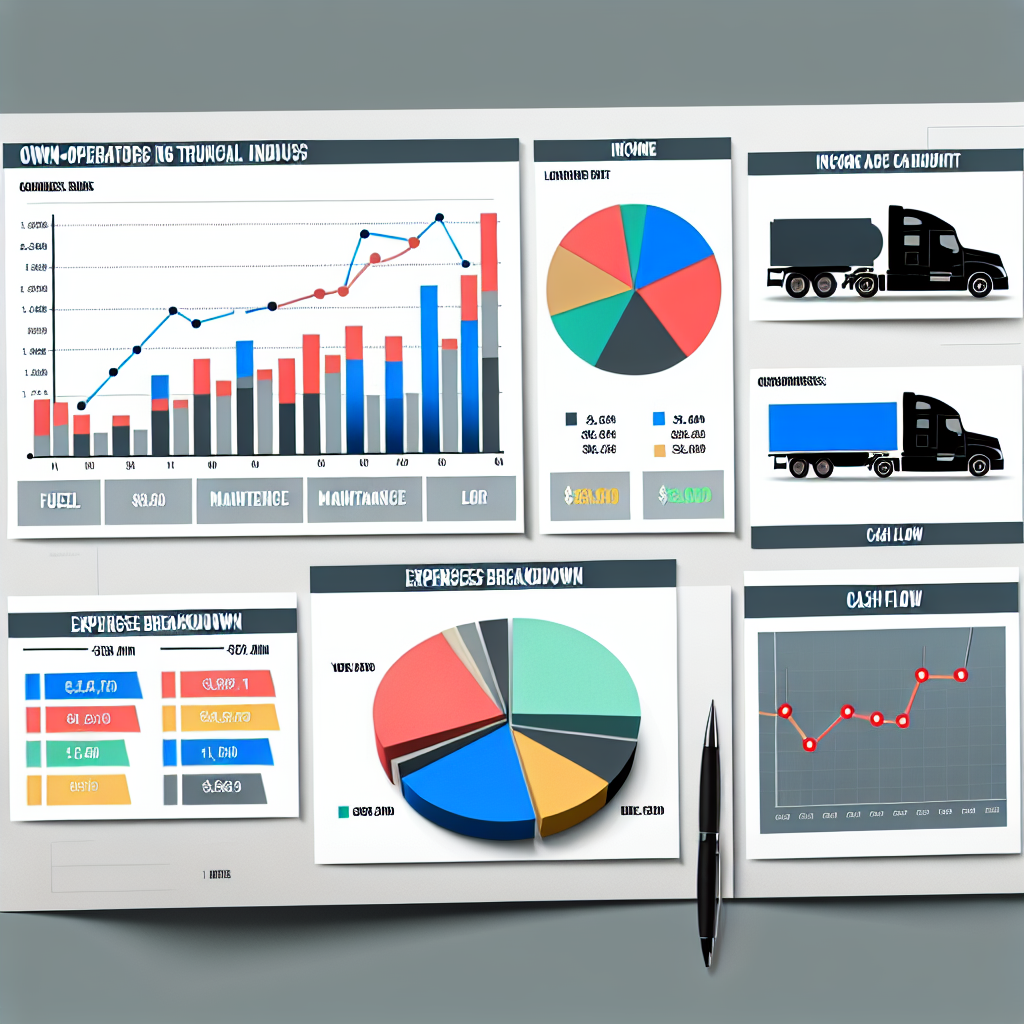The trucking industry is undergoing significant changes, particularly for owner-operators who face a unique set of challenges. The need for a deep financial analysis becomes crucial as they navigate rising costs and fluctuating freight demand.
With ATBS leading the charge in providing insightful analysis and data, it is essential to understand the trends that are shaping the future of this sector. As we delve into the current state of owner-operator trends, we must ask ourselves: are conditions starting to improve, or will the headwinds continue?

Key Financial Trends in the Trucking Industry for Owner-Operators
As we explore the latest financial trends for owner-operators in trucking, several key aspects have emerged:
Freight Rates and Load Availability
The spot market has seen big changes. In September 2025, the load-to-truck ratio was 88 loads per truck, and freight rates fell to an average of $1.88 per mile. This is much lower than the $2.74 per mile we saw in November 2021. This decline shows the gap between supply and demand in the freight market, leading to more competition and lower earnings for many operators. We must ask: What are the latest miles, rates, fuel costs, and maintenance trends?
Operational Costs
A major factor impacting profit is the rise in operational costs, which includes:
- Fuel Expenses: Fuel costs per mile have decreased by about 10%. This is due to lower diesel prices and better fuel efficiency (average MPG is now 7.12). However, this drop may not fully balance out the rising costs in other areas.
- Maintenance Costs: Owner-operators are spending about $100 more per month on maintenance, which is a 10% increase. This rise is due to higher labor costs, expensive parts, and the need to maintain older trucks since fewer new ones are available.
Reports say that changes in immigration policies and competition for skilled drivers have led to higher labor costs, particularly affecting regional and long-haul operators.
- Fixed Costs: Fixed costs have risen by 2% compared to last year, adding about $1,189 annually to expenses.
Income Trends
Despite the challenges, owner-operator net income has grown slightly by 2.5%, averaging $64,524. This improvement is more common in dry van and flatbed sectors, while refrigerated operations are struggling. Meanwhile, revenue per mile has dropped by 3.7% from last year. This primarily results from lower fuel surcharges and falling base rates, meaning many operators now drive more miles, averaging 94,000 annually.
Market Outlook
Looking ahead, owner-operators face challenges but remain cautiously optimistic. For example, while companies like Landstar System report a 10% decrease in owner-operator truck counts, about 33% of operators expect demand to rise in the next months. Proper cost management and adaptability will be crucial for sustainability and profit.
In conclusion, owner-operators are working in a challenging financial environment with changing freight rates and rising operational costs. To stay profitable in a competitive market, understanding these trends is essential. As Mike Hosted, Vice President at ATBS, wisely pointed out: Are conditions improving, or do challenges remain?
Additionally, recent laws like the One Big Beautiful Bill Act raise questions about potential tax benefits for owner-operators. How can owner-operators benefit from the One Big Beautiful Bill Act?
Challenges Faced by Owner-Operators
Owner-operators in the trucking industry are currently grappling with significant operational challenges, primarily due to escalating costs and diminished freight demand. The evolving landscape presents numerous obstacles that impact profitability and sustainability for these small-business owners.
-
Soft Freight Demand and Overcapacity
The freight market has experienced a downturn, with the Cass Freight Index indicating an over 8% year-over-year decline in shipments as of January 2025. This reduction has led to increased competition among carriers, particularly affecting independent owner-operators who often lack the bargaining power of larger fleets. The oversupply of trucks, a remnant of the 2021 freight boom, exacerbates this issue, making it challenging for smaller operators to secure profitable loads.
-
Rising Operational Costs
Despite a slight decrease in fuel prices in 2023, other operational expenses have surged. The American Transportation Research Institute (ATRI) reported that non-fuel operating costs reached $1.779 per mile, the highest ever recorded. This increase is attributed to higher maintenance costs, insurance premiums, and equipment expenses. For instance, truck and trailer payments rose by 8.3%, averaging 39 cents per mile.
-
Maintenance and Repair Expenses
With new trucks being scarce and used truck prices soaring, many owner-operators are retaining older vehicles, leading to higher maintenance costs. The shortage of diesel mechanics and rising shop rates, often exceeding $200 per hour, further strain their finances. Extended downtime due to parts shortages can be particularly detrimental to small operators.
-
Regulatory Compliance
Navigating complex regulations, such as Hours of Service (HOS) rules and Electronic Logging Device (ELD) mandates, poses additional challenges. Non-compliance can result in substantial fines and penalties, further impacting profitability.
-
Limited Bargaining Power
In a loose freight market, brokers and shippers hold more leverage, often pressuring independent owner-operators to accept unprofitable loads just to keep moving. This lack of negotiating power has compelled some to take cheap freight or sit idle, neither of which is sustainable.
Insights from Industry Experts
Mike Hosted, Vice President at ATBS, has provided insights into these challenges. In September 2024, he noted a period of cost stability for owner-operators, where fixed costs had increased by 3% year-over-year, alongside a decrease in variable costs by 6.3%. He expressed cautious optimism, hinting that such stability might offer cost certainty amid a freight-rate stagnation that could last another six months to a year.
Despite a 7.6% increase in gross revenue over 2020, Hosted noted the disparity between gross revenues and net income, with the latter rising by only 5.1%. This illustrates that operational costs are consuming a significant portion of revenue gains, complicating efforts to translate higher revenues into profitability. Moreover, an observed increase in average mileage by nearly 8% in 2023, as owner-operators sought to offset profit declines during a weak freight market, signals adaptive strategies in a challenging environment.
These challenges have led many owner-operators to consider significant changes to their business models, including downsizing, switching regions, leasing onto larger carriers, or even exiting the industry altogether. The current environment underscores the need for strategic planning and adaptability to navigate the evolving landscape of the trucking industry.
Operational Performance Benchmarks
| Benchmark | 2022 | 2023 | 2024 | 2025 (Projected) |
|---|---|---|---|---|
| Average Income | $62,000 | $63,000 | $64,000 | $66,000 |
| Average Operational Cost | $2.37 per mile | $2.27 per mile | $2.26 per mile | $2.28 per mile |
| Non-Fuel Operating Costs | $1.714 per mile | $1.717 per mile | $1.779 per mile | $1.85 per mile |
| Truck Payment Cost | $0.36 per mile | $0.38 per mile | $0.39 per mile | $0.40 per mile |
| Profit Margin | -1.8% | 0.1% | -2.3% | -1.5% |
Key Insights:
The average income for owner-operators has shown a slight recovery from the lows in 2021.
Operational performance benchmarks illustrate the ongoing pressure of rising costs. Adopting cost management practices becomes essential in improving these metrics.
Non-fuel operating costs have risen, highlighting increasing expenses in maintenance and truck payments.
Sources:
- ATBS report on owner-operators’ performance
- American Transportation Research Institute (ATRI) findings
- Overdrive Online analysis
- FreightWaves insights
Financial Performance Trends for Owner-Operators
The financial performance trends for owner-operators in the trucking industry reveal a complex interplay between rising operational costs, fluctuating freight rates, and cautious investment confidence. These elements significantly influence the profitability and sustainability of owner-operator businesses in an increasingly competitive market.
Maintenance Costs
Maintenance remains a pivotal aspect of operational expenses for owner-operators. In 2024, the average repair and maintenance costs were reported at approximately 19.8 cents per mile, a minor decrease from 2023. However, many owner-operators still faced a notable increase in maintenance expenses, estimating an additional $100 per month due to the rising costs of parts and labor, as well as the necessity to maintain aging equipment. This emphasis on older vehicles is driven by the high prices of new trucks, reflecting a broader trend in small-business trucking. As a result, effective maintenance management becomes vital for sustaining profitability in a challenging economic landscape.
Freight Rates
Freight rates have undergone considerable volatility, impacting owner-operators’ revenue streams. The spot market, a crucial source of income, has experienced swings that left many operators vulnerable. For instance, while freight rates peaked at $2.74 per mile in late 2021, they plummeted to averages around $1.88 per mile in September 2025. The load-to-truck ratio also indicates competition, with the ratio shifting to 88 loads per truck, an improvement from recent lows but still reflective of an overall decline in freight demand. Such fluctuations necessitate strategic pricing and load selection to maximize revenue.
Investment Confidence
Investment confidence among owner-operators remains cautiously optimistic yet tempered by rising equipment costs. The price of new trucks has soared, averaging $186,000 in early 2025—a staggering 32.3% increase year-over-year. This surge compels many operators to explore used truck options, although these come with potentially higher long-term maintenance costs. Legislative measures like the One Big Beautiful Bill Act (OBBBA) provide some relief by offering 100% first-year bonus depreciation on qualifying equipment. This can significantly improve cash flow and reduce tax liabilities for owner-operators, enhancing their ability to invest in necessary upgrades and equipment.
Conclusion
In summary, owner-operators in the trucking industry are grappling with a web of financial performance trends unique to their operational landscape. Rising maintenance costs, fluctuating freight rates, and cautious investment confidence pose significant challenges. As these small-business operators navigate these complexities, understanding and strategically managing these financial elements is crucial to maintaining profitability and long-term success in the trucking sector. The insights gleaned from recent statistics and trends underscore the importance of proactive planning and adaptability in a rapidly changing industry.
Owner-operators in the trucking industry are experiencing significant economic challenges, leading to a growing reliance on various financial tools to manage their finances effectively. Key tools adopted include freight factoring, fuel cards, and comprehensive financial management services offered by platforms like ATBS.
Freight Factoring has emerged as a crucial resource for owner-operators to maintain steady cash flow. According to a 2025 Truckstop survey, nearly 80% of carriers using factoring intend to factor the same or more loads this year. This highlights an increasing dependence on factoring services, which allow owner-operators to access funds quickly, helping them to cover operational costs even when facing delayed payments from shippers.
Fuel Cards have also gained traction among owner-operators, providing not only discounts on fuel purchases but also robust tracking tools for fuel consumption and expense management. The utilization of fuel cards helps streamline one of the largest expenditures in the trucking business, enabling operators to optimize their fuel economy and control costs effectively.
In addition, the enhanced financial management offerings from ATBS, including bookkeeping and tax preparation services, play a crucial role in the financial landscape of owner-operators. The “ATBS Hub” mobile app introduces innovative features that allow users to scan receipts, track deductions, and analyze various aspects of their business financials with ease. This level of insight can empower owner-operators to make informed decisions, thus improving their financial health in a competitive market.
The adoption of these financial tools collectively assists owner-operators in navigating today’s economic challenges by enhancing cash flow, fostering better expense management, and simplifying the complex aspects of financial documentation and strategy. ATBS provides tailored solutions that resonate deeply with the needs of owner-operators, advocating for technology integration in their financial practices. This synergy between adopting financial tools and leveraging ATBS’s services sets a promising foundation for improving profitability and sustainability in the trucking industry.
Owner-operators in the trucking industry can benefit from various financial management tools to navigate the economic challenges they face. Some notable industry resources include:
Industry Resources for Financial Management
-
Porter Freight Funding
Offering freight factoring with rapid funding and a mobile app for managing trucking operations, providing up to 100% invoice value paid within 24 hours, along with fuel card programs. -
eCapital
Provides freight factoring with invoice payments processed in as little as an hour and pre-approved fuel credits, helping owner-operators manage finances effectively. -
TAFS (TransAm Financial Services)
Focused on freight factoring and business financing with 24/7 support and a mobile app for account management, helping to improve cash flow and financial planning. -
Quickpay Funding
Offers same-day funding for invoices and discounts on fuel purchases, vital for managing expenses and ensuring quick cash flow. -
AutoFreightFactoring
Specializes in freight factoring for owner-operators, providing fuel advances and dedicated support.
These tools can greatly assist owner-operators in enhancing cash flow and managing finances effectively as they navigate the complexities of the trucking industry.
Further, adopting various strategies can aid in the user adoption of these essential financial tools:
Best Practices for User Adoption of Financial Tools
- Utilize Freight Factoring Services: Look for services that offer same-day payments, reducing financial strain significantly.
- Implement Load Boards and Freight-Matching Apps: Tap into real-time resources for better load selection and pricing strategies.
- Adopt Fuel Management Applications: Use apps that can help track fuel prices and optimize stops to save on fuel costs.
- Invest in Fleet Management Software: These technologies improve operations through better monitoring and compliance.
- Utilize Document Scanning Apps: Streamline documentation processes to reduce administrative burdens.
- Automate Expense Tracking: Integrate financial data into bookkeeping to manage expenses effortlessly.
- Establish a Dedicated Business Bank Account: This practice provides clarity in financial management and protects personal assets.
- Develop a Comprehensive Business Plan: A solid business plan guides operations and growth.
- Diversify Your Customer Base: Mitigate risks by avoiding over-reliance on a single source of income.
- Engage in Continuous Learning: Stay updated on industry trends to maintain competitiveness.
By leveraging these tools and strategies, owner-operators can enhance their operational efficiency and improve their financial health in the trucking sector.

In conclusion, owner-operators are navigating a challenging financial environment that requires strategic management and adaptability. As Mike Hosted, Vice President at ATBS, noted:
“If you drive a little slower, you will be more efficient. Use cruise when it makes sense, cut out of route miles and cut idling when it’s appropriate.”
This insight serves to remind owner-operators that optimizing operations can aid in profitability, especially amidst fluctuating freight rates and rising operational costs.
By focusing on efficiency, embracing technological advancements, and staying informed about market dynamics, owner-operators can position themselves for success in the trucking industry. As we prepare for the upcoming trends data session on September 30, 2025, it is crucial to remain engaged with these developments that will shape the future of trucking.
| Average Income | Average Operational Costs |
|---|---|
| $62,000 (2022) | $2.37 per mile (2022) |
| $63,000 (2023) | $2.27 per mile (2023) |
| $64,000 (2024) | $2.26 per mile (2024) |
| $66,000 (2025 projected) | $2.28 per mile (2025 projected) |
| Non-Fuel Operating Costs | Truck Payment Cost |
|---|---|
| $1.714 per mile (2022) | $0.36 per mile (2022) |
| $1.717 per mile (2023) | $0.38 per mile (2023) |
| $1.779 per mile (2024) | $0.39 per mile (2024) |
| $1.85 per mile (2025 projected) | $0.40 per mile (2025 projected) |
| Profit Margin |
|---|
| -1.8% (2022) |
| 0.1% (2023) |
| -2.3% (2024) |
| -1.5% (2025 projected) |
